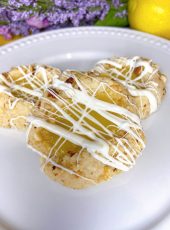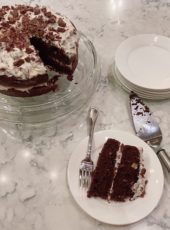Once eaten only by the upper crust in Northern China, these wontons get an American twist with goat cheese and avocado – don’t forget the dipping sauce!
“Every culture has their version of meat wrapped in dough – dumplings, empanadas, samosas, British meat pies, calzones – and I love them all.” – my neighbor on the evening we shared these wontons and her dumplings
It’s true: filling stuffed inside dough is always satisfying, and the basic concept is the same across a lot of cultures. Perhaps this is why, as Taste Atlas shares, wontons are sometimes referred to as “Chinese ravioli.” They also have a lot in common with Chinese dumplings – meat, seafood, or veggie filling, wrapped in dough – though wontons have a thinner shell. Wontons were created as a kind of dumpling during the Tang dynasty, around the 1600’s, where they were steamed in soups and eaten by wealthy families. It wasn’t until after WWII that wonton soup popularized among the working class, where street vendors or “hawker stalls” sold the dish on the streets of Hong Kong.
As a note, if we credit the theory of wontons as a kind of dumpling, they’re much older than Italian ravioli. Where ravioli can be dated to around the 1300’s, many sources agree that dumplings can be traced to the Han dynasty era (206 BC – 220 AD). Maybe we should call ravioli “Italian dumplings.”

Originally wontons were called “hun dun,” or “chaos” in Northern China because of the many sides that need to be sealed together; the current word means “clouds” in Cantonese referring to their pillowy texture and the way they float in soup. They’ve been eaten by the upper crust, prepared as offerings to deceased ancestors, warmed the soul during the winter solstice festival of Dongzhi, and fed laborers. And this is all before their journey across the Pacific Ocean.
The journey of this one food – from steamed clouds for royalty to crab rangoon for greasy hangover cures – is symbolic of much larger cultural forces. It tells the story of immigrants’ attempts to belong in a new hostile climate as well as the inner workings of America’s “melting pot.” Food can be a powerful vehicle for cultural appreciation. As Kion You, writing for Brown Political Review writes, “An expansion of the American palate, however subtle, does occur with the consumption of foreign food, which may be followed by a small opening of the American mind as it learns about the intricacies of other cultures via their cuisines.” A particularly American enactment of “sharing” occurs through fusion, combining elements of various cuisines to create a new one. You writes that we can trace the first Asian fusion to Chinatown immigrants in the late 1800’s who translated their recipes to an American palate (think Chop Suey and sweet dipping sauces).
The 1965 Immigration and Nationality Act challenged the bias in our quota limitations for non-European nations, creating a wave of mass entry of Asian immigrants. It’s with this increase in immigration that an American interest in Asian dishes proliferated. According to Chantal Martineau, writing for The Atlantic, Richard Wing is credited with created one of the first moments of fusion cuisine when he combined elements of Chinese and French cooking in the 1960’s, working out of his family’s restaurant in Hanford, California, Imperial Dynasty.
Aside from Wing’s due credit, it’s mostly white chefs who are written into the food history books in regard to fusion. It’s Victor Bergeron, the founder of Trader Vic’s, who created Crab Rangoon in the 1950’s, leading the way in America’s “Polynesian pop”: the interest in tiki that followed the return of WWII soldiers who raved about their adventures in tropical locales. It’s a white chef who coined the term “Asian fusion” in the 1980’s. And chefs like Wolfgang Puck who capitalized off of the 1980’s yuppie interest in exotic – but still comfortable – Asian inspired café classics. To quote You again, “Asian fusion food doesn’t endeavor to transport its eater to a distant country, as ethnic food can, but instead, desires to highlight the very inauthentic, mangled, cultural forces that mash together to form, in short, an ‘American.’”
Of course, I was utterly unaware of this history when I created this recipe. When I was in a senior in high school – I’ll leave the exact year a mystery – I saw Emeril Lagasse making shrimp wontons on Food Network, and I thought, “Oh, what if I put all of my favorite things in a fried shell!?!” And these avocado goat cheese wontons were born. A bit later I found a recipe for the ginger bourbon dipping sauce in Family Circle magazine, my mother’s copy I’m sure. I know that there is a negative interpretation to take of these bastardized wontons I created so many years ago. More optimistically, I like to think that these wontons are a bright spot of cultural fusion: the mangled, mashed together, inexplicable pieces of American cuisine. And goat cheese and avocado inside fried dough is super delicious.
Avocado Goat Cheese Wontons
(with Ginger Bourbon Duck Sauce)
Recipe by MauraCourse: AppetizersDifficulty: Easy6
servings45
minutes4
minutesIngredients
- For the Wontons
~ 18 wonton shells (about half of the package)
4 oz goat cheese, crumbled (classic/no flavor)
1/2 cup chopped ripe avocado (~1 medium or 1.5 small avocados)
1 green onion chopped (green and white parts)
1 to 2 TBSP sun-dried tomatoes in oil (depending on taste), chopped
1 TBSP oil from sun-dried tomatoes jar
2 tsp minced garlic (~1 large clove)
(water for sealing edges)
canola oil for frying, enough for wontons to be submerged
- Ginger Bourbon Duck Sauce
2 TBSP canola oil
1/4 cup chopped red pepper
1 TBSP fresh chopped ginger
1 TBSP fresh chopped garlic
2 TBSP Bourbon
1 cup prepared duck sauce
Directions
- For the Wontons
- Gently toss the goat cheese crumbles, avocado, green onion, sun-dried tomatoes, oil from sun-dried tomatoes, and garlic. You want it to be well mixed, but for the avocado to mostly keep its shape.
- Place about 1 tsp of the mixture in the center of the wonton - do not overfill.
- Brush all the edges of the wonton with water and pull the edges up toward the center to fold them closed.
- Fry in small batches, for 3-4 minutes, until golden browned. [See note about baking or air frying.]
- For Ginger Bourbon Duck Sauce
- Heat 2 TBSP canola oil in pan
- Add red pepper, garlic, and ginger; Cook for 1 minute
- Add 2 Bourbon and allow alcohol to cook off, about 30 seconds
- Add prepared duck sauce, stir and cook for 1 minute
Notes
- Time (4 minutes) refers to each batch. Fry in batches of about ~4 or ~6 at a time, depending on size of your vessel.
- To air fry: spray with cooking spray, and place in a single layer so wontons are not touching. Air fry for 8 minutes at 370F degrees. To bake: spray with cooking spray, bake for 5-7 minutes at 400F degrees. Neither of these methods will be as browned or flavorful - but they'll be healthier!
- Wonton recipe by me; Duck Sauce recipe originally from Family Circle magazine.





